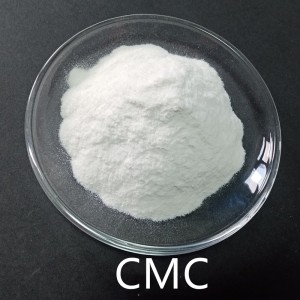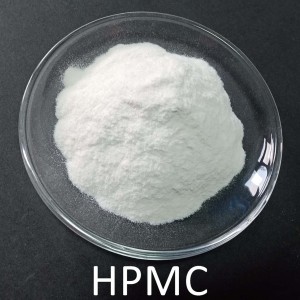Featured Products
-

Wholesale ODM Factory Direct Supply Cellulose Thickener Manufacturers HPMC/HEC/CMC/Mc Hydroxy Ethyl Cellulose HEC Manufacturer
CAS: 9004-32-4
Carboxymethyl Cellulose(CMC) is an anionic water soluble polymer derived from the world’s most abundant polymer – cotton cellulose.It is also known as cellulose gum , and its sodium salt are important cellulose derivatives. The bound carboxymethyl groups (-CH2-COOH) along the polymer chain makes the cellulose water-soluble. When dissolved, it increases the viscosity of aqueous solutions, suspensions and emulsions, and at higher concentration, it provides pseudo-plasticity or thixotropy. As a natural polyelectrolyte, CMC imparts a surface charge to neutral particles and can be used to improve the stability of aqueous colloids and gels or to induce agglomeration. It provides good properties of thickening, water retention, film-forming, rheology and lubricity, which is widely used in food, personal care products, industrial paints, ceramics, oil drilling, building materials etc.
-

Hot Sale for Premium Supplier Sodium Carboxymethyl Cellulose CMC Powder
CAS: 9004-32-4
Carboxymethyl Cellulose(CMC) is an anionic water soluble polymer derived from the world’s most abundant polymer – cotton cellulose.It is also known as cellulose gum , and its sodium salt are important cellulose derivatives. The bound carboxymethyl groups (-CH2-COOH) along the polymer chain makes the cellulose water-soluble. When dissolved, it increases the viscosity of aqueous solutions, suspensions and emulsions, and at higher concentration, it provides pseudo-plasticity or thixotropy. As a natural polyelectrolyte, CMC imparts a surface charge to neutral particles and can be used to improve the stability of aqueous colloids and gels or to induce agglomeration. It provides good properties of thickening, water retention, film-forming, rheology and lubricity, which is widely used in food, personal care products, industrial paints, ceramics, oil drilling, building materials etc.
-

18 Years Factory Carboxymethyl Cellulose CMC Sodium for Detergent Paint and Coating
CAS: 9004-32-4
Carboxymethyl Cellulose(CMC) is an anionic water soluble polymer derived from the world’s most abundant polymer – cotton cellulose.It is also known as cellulose gum , and its sodium salt are important cellulose derivatives. The bound carboxymethyl groups (-CH2-COOH) along the polymer chain makes the cellulose water-soluble. When dissolved, it increases the viscosity of aqueous solutions, suspensions and emulsions, and at higher concentration, it provides pseudo-plasticity or thixotropy. As a natural polyelectrolyte, CMC imparts a surface charge to neutral particles and can be used to improve the stability of aqueous colloids and gels or to induce agglomeration. It provides good properties of thickening, water retention, film-forming, rheology and lubricity, which is widely used in food, personal care products, industrial paints, ceramics, oil drilling, building materials etc.
-

OEM China HPMC Hydroxypropyl Methyl Cellulose for Tile Adhesive and Good Performance Concrete
CAS NO.:9004-65-3
Hydroxypropyl Methylcellulose (HPMC) are non-ionic cellulose ether & its derivatives that have hyrdroxyl groups on the cellulose chain substituted for a methoxy or hydroxypropyl group. HPMC is made from natural cotton linter under chemical reaction,which can be dissolved in both cold water and hot water to form a transparent solution. HPMC is used as a thickener, binder, and film former in construction, pharmaceutical,food, cosmetic, detergent, paints, adhesives, inks, PVC and various other applications.
-

Excellent quality Factory Detergent Raw Materials Cellulose Industry Chemical CAS 9004-65-3 HPMC
CAS NO.:9004-65-3
Hydroxypropyl Methylcellulose (HPMC) are non-ionic cellulose ether & its derivatives that have hyrdroxyl groups on the cellulose chain substituted for a methoxy or hydroxypropyl group. HPMC is made from natural cotton linter under chemical reaction,which can be dissolved in both cold water and hot water to form a transparent solution. HPMC is used as a thickener, binder, and film former in construction, pharmaceutical,food, cosmetic, detergent, paints, adhesives, inks, PVC and various other applications.
-

Best Price for CMC CAS No. 9004-32-4 Fiber Sodium Carboxymethyl Industrial Oil Drilling Machones CMC-LV Hv Low Viscosity Carboxymethyl Cellulose Sodium CMC
CAS: 9004-32-4
Carboxymethyl Cellulose(CMC) is an anionic water soluble polymer derived from the world’s most abundant polymer – cotton cellulose.It is also known as cellulose gum , and its sodium salt are important cellulose derivatives. The bound carboxymethyl groups (-CH2-COOH) along the polymer chain makes the cellulose water-soluble. When dissolved, it increases the viscosity of aqueous solutions, suspensions and emulsions, and at higher concentration, it provides pseudo-plasticity or thixotropy. As a natural polyelectrolyte, CMC imparts a surface charge to neutral particles and can be used to improve the stability of aqueous colloids and gels or to induce agglomeration. It provides good properties of thickening, water retention, film-forming, rheology and lubricity, which is widely used in food, personal care products, industrial paints, ceramics, oil drilling, building materials etc.
-

Factory supplied Food Ingredient Emulsifier (Carboxyl Methyl Cellulose) CMC for Ice Cream
CAS: 9004-32-4
Carboxymethyl Cellulose(CMC) is an anionic water soluble polymer derived from the world’s most abundant polymer – cotton cellulose.It is also known as cellulose gum , and its sodium salt are important cellulose derivatives. The bound carboxymethyl groups (-CH2-COOH) along the polymer chain makes the cellulose water-soluble. When dissolved, it increases the viscosity of aqueous solutions, suspensions and emulsions, and at higher concentration, it provides pseudo-plasticity or thixotropy. As a natural polyelectrolyte, CMC imparts a surface charge to neutral particles and can be used to improve the stability of aqueous colloids and gels or to induce agglomeration. It provides good properties of thickening, water retention, film-forming, rheology and lubricity, which is widely used in food, personal care products, industrial paints, ceramics, oil drilling, building materials etc.
-

Reliable Supplier Collector Flotation Depressant Mineral Processing Additive Flotation Reagent Granular CMC
CAS: 9004-32-4
Carboxymethyl Cellulose(CMC) is an anionic water soluble polymer derived from the world’s most abundant polymer – cotton cellulose.It is also known as cellulose gum , and its sodium salt are important cellulose derivatives. The bound carboxymethyl groups (-CH2-COOH) along the polymer chain makes the cellulose water-soluble. When dissolved, it increases the viscosity of aqueous solutions, suspensions and emulsions, and at higher concentration, it provides pseudo-plasticity or thixotropy. As a natural polyelectrolyte, CMC imparts a surface charge to neutral particles and can be used to improve the stability of aqueous colloids and gels or to induce agglomeration. It provides good properties of thickening, water retention, film-forming, rheology and lubricity, which is widely used in food, personal care products, industrial paints, ceramics, oil drilling, building materials etc.






